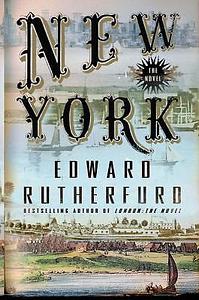Take a photo of a barcode or cover
I've always enjoyed Edward Rutherford's books. This one is no exception. His combination of historical events with the lives of his own characters brings the evolution of New York alive. Brings you from the edge of Manhattan to post 9/11. Great read.
adventurous
informative
inspiring
relaxing
slow-paced
Plot or Character Driven:
Plot
Strong character development:
Yes
Loveable characters:
Complicated
Diverse cast of characters:
Yes
Flaws of characters a main focus:
Yes
Just didn't like this. The story wasn't engaging, the history was kind of boring, and the tone was very condescending.
I liked this better than Sarum but not as much as London. This was a well written book, but I felt some of the vignettes dragged on a bit. I felt that this book was easier to follow in regards to the families than Sarum AND London. He did hit the major historical turning points. Maybe if I was a New Yorker this book would have really done it for me, but I am biased towards the Second City.
3.8. The author obviously did a lot of research. Characters were interesting to follow.
Another centuries-spanning work of fiction by Edward Rutherfurd, and the first one he's done looking at a U.S. city.
Most Edward Rutherfurd books span at least a millennium, and often have dozens of characters, making up several families, that weave in and out of the story as he jumps from time period to time period. This keeps his books fast-paced and intriguing, despite the number of pages.
New York, however, only spans about 350 years. We jump in after Dutch colonization, and follow it from there. Because of this compressed timeline (strange to call 350 years compressed, but in an ER book, it is) and the fact that the book still has the same amount of pages, we rarely make big leaps of time. He also didn't have enough time to set up several different families to follow generationally. Because of both of these things, the book feels much more like one very long story than his previous works, and basically follows one family, the Masters, with a couple cameos by other families who may not last more than 1 or 2 generations. This means that if there's a certain character you hate, or get sick of, then settle in, cause they're probably sticking around for 200 pages or more. (Rose Master, I'm looking at you!)
I wish that this book had been set up more like his other ones, which are quick and easy reads, despite their page length. However, this book is still a lot of fun, especially if you are already a Rutherfurd fan and like this type of historical fiction. There were times that I got very very into the story, to the point of not wanting to put it down, and times (like the 9/11 storyline) when I got genuinely emotionally involved, and other times when I just thought "Is the revolutionary war EVER going to end??"
3.5/5 stars, rounded up to 4.
Most Edward Rutherfurd books span at least a millennium, and often have dozens of characters, making up several families, that weave in and out of the story as he jumps from time period to time period. This keeps his books fast-paced and intriguing, despite the number of pages.
New York, however, only spans about 350 years. We jump in after Dutch colonization, and follow it from there. Because of this compressed timeline (strange to call 350 years compressed, but in an ER book, it is) and the fact that the book still has the same amount of pages, we rarely make big leaps of time. He also didn't have enough time to set up several different families to follow generationally. Because of both of these things, the book feels much more like one very long story than his previous works, and basically follows one family, the Masters, with a couple cameos by other families who may not last more than 1 or 2 generations. This means that if there's a certain character you hate, or get sick of, then settle in, cause they're probably sticking around for 200 pages or more. (Rose Master, I'm looking at you!)
I wish that this book had been set up more like his other ones, which are quick and easy reads, despite their page length. However, this book is still a lot of fun, especially if you are already a Rutherfurd fan and like this type of historical fiction. There were times that I got very very into the story, to the point of not wanting to put it down, and times (like the 9/11 storyline) when I got genuinely emotionally involved, and other times when I just thought "Is the revolutionary war EVER going to end??"
3.5/5 stars, rounded up to 4.
informative
slow-paced
Plot or Character Driven:
A mix
Strong character development:
Yes
Loveable characters:
Complicated
Diverse cast of characters:
Complicated
Flaws of characters a main focus:
Complicated
I've had several Rutherfurd novels on my bookshelf for a couple of years now, always purchased with an intent to read them immediately that never panned out. "New York" was one I picked up on the cheap on a day when I didn't already happen have a book with me, so when I stopped into a coffee shop on the way home, I started reading.
And kept reading.
"New York" had my attention from the first few pages. As a narrative work of historical fiction, it's fantastic. Following the Master family, and a couple of side families that become intrinsically linked along the way, Rutherfurd covers New York from its Dutch colonization to shortly after the tragic fall of the Twin Towers. Eminently readable despite its massive scope and occasionally difficult subject matter, the highs and lows of this well-to-do family from their fur trapping days of the late 1600's to the big-money Wall Street world of the 2000's make for an entertaining read.
As a strict, all-encompassing historical account: it falls short. Readers expecting to learn all the intimate details about New York City's growth over the centuries, or experience the viewpoint of every ethnicity that exists in such a wildly diverse city will be disappointed. Rutherfurd chose a very specific viewpoint family (who, through the benefit of wealth are capable of experiencing the history of New York in a very specific way) and that family might not sit well with those looking for more diversity in race, religion, sexuality or even financial stature. Despite this, he makes a valiant effort in 800 pages of fiction to weave some other possible experiences of slaves, immigrants and the poor into the story in a number of ways. No single historical account will ever account for every viewpoint, but Rutherfurd still manages to tackle a lot and make it entertaining the whole way through.
Five stars. Would read again, but instead I'll probably settle for those other dusty unread Rutherfurd's on my shelf.
And kept reading.
"New York" had my attention from the first few pages. As a narrative work of historical fiction, it's fantastic. Following the Master family, and a couple of side families that become intrinsically linked along the way, Rutherfurd covers New York from its Dutch colonization to shortly after the tragic fall of the Twin Towers. Eminently readable despite its massive scope and occasionally difficult subject matter, the highs and lows of this well-to-do family from their fur trapping days of the late 1600's to the big-money Wall Street world of the 2000's make for an entertaining read.
As a strict, all-encompassing historical account: it falls short. Readers expecting to learn all the intimate details about New York City's growth over the centuries, or experience the viewpoint of every ethnicity that exists in such a wildly diverse city will be disappointed. Rutherfurd chose a very specific viewpoint family (who, through the benefit of wealth are capable of experiencing the history of New York in a very specific way) and that family might not sit well with those looking for more diversity in race, religion, sexuality or even financial stature. Despite this, he makes a valiant effort in 800 pages of fiction to weave some other possible experiences of slaves, immigrants and the poor into the story in a number of ways. No single historical account will ever account for every viewpoint, but Rutherfurd still manages to tackle a lot and make it entertaining the whole way through.
Five stars. Would read again, but instead I'll probably settle for those other dusty unread Rutherfurd's on my shelf.
It took me a while to get through this book. I enjoyed the history, but every time I started to get attached to a character - the story moved on to someone else. That is the nature of sagas, I know, so I should have expected it. It just wasn't want I wanted at this time.
There is a lot of history. The characters interact with many of the memorable characters in US history.
There is a lot of history. The characters interact with many of the memorable characters in US history.
If you like a lot of history with your fiction, you’ll like this book. It’s very thoroughly researched, and it reads like a time-lapsed photograph of New York dating from the 16th century to the present. You can see the buildings grow, the town change, the various ethnic groups make their entrances, and the power centers shift.
In terms of its fictional appeal, it’s on the weak side. In order to cover so much territory, it moves from one generation to the next with great speed. It focused mainly on a rich white family, the Masters family, going from father to son. There are side-stories dealing with indigenous Americans, Dutch, Irish, Italians, and Jews, and an African-American family is tracked for a few generations. The latter was actually one of the more interesting story-lines but was dropped rather abruptly.
Some of the characters stand out, but many of them are a little blurry. Wealth – the gaining and losing of it – is a recurring theme, and the novel is full of very detailed descriptions of the way New York’s richest have lived through the centuries. One of the last stories has a rather moralistic ending, with the message that it isn’t healthy to be driven entirely by one’s ambition for money and prestige. But the message is thin in contrast to everything that’s come before.
In terms of its fictional appeal, it’s on the weak side. In order to cover so much territory, it moves from one generation to the next with great speed. It focused mainly on a rich white family, the Masters family, going from father to son. There are side-stories dealing with indigenous Americans, Dutch, Irish, Italians, and Jews, and an African-American family is tracked for a few generations. The latter was actually one of the more interesting story-lines but was dropped rather abruptly.
Some of the characters stand out, but many of them are a little blurry. Wealth – the gaining and losing of it – is a recurring theme, and the novel is full of very detailed descriptions of the way New York’s richest have lived through the centuries. One of the last stories has a rather moralistic ending, with the message that it isn’t healthy to be driven entirely by one’s ambition for money and prestige. But the message is thin in contrast to everything that’s come before.


